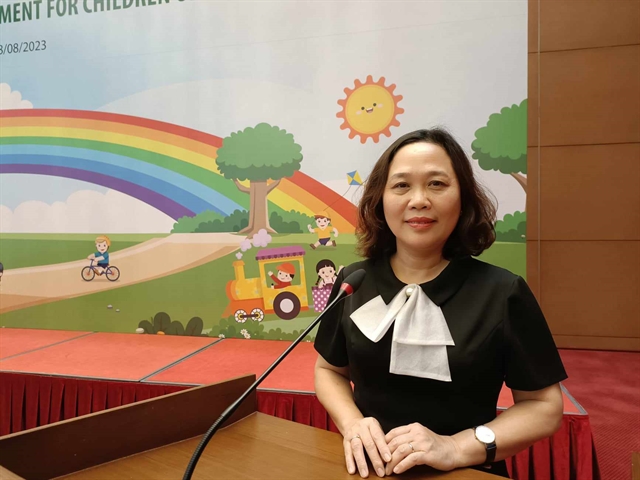 Opinion
Opinion

 |
| Vũ Thị Kim Hoa, Deputy Head of the Ministry of Labour, Invalids, and Social Affairs' Department of Child Affairs. – VNS Photo Khánh Linh |
Although the number of accidents and injuries suffered by children has dropped over the last decade, they still remain at a high level in Việt Nam. Establishing a secure environment for children, at home, in schools and the community, is recognised as a critical undertaking to reduce accidents and injuries. Việt Nam News reporter Khánh Linh spoke to Vũ Thị Kim Hoa, Deputy Head of the Ministry of Labour, Invalids, and Social Affairs' Department of Child Affairs about the issue.
Could you provide insights into the current situation of child injuries in Việt Nam?
Child injuries result in significant losses for the society and families and are one of the leading causes of death and disability among children and adolescents in many countries worldwide, especially in low- and middle-income nations.
According to the World Health Organization (WHO) report in 2019, there were nearly 250,000 cases of children under six years old dying due to injuries globally, with 98 per cent of these cases occurring in middle- to lower-income countries.
In Việt Nam, over the past decade, child injury rates have shown a decreasing trend but still remain high.
On average, around 3,900 children under 15 years old die each year due to various causes. The 2019 report indicated that the child mortality rate in Việt Nam decreased from an average of 17.3 per 100,000 children annually to 17 per 100,000 children in 2020.
Drowning is the leading cause of deaths in Việt Nam, with nearly 2,000 children dying from it every year.
Notably, 55 per cent of these accidents occur at home, and the rest occur at schools and the community.
Việt Nam has established a comprehensive legal framework and policies for preventing child injuries. The National Assembly has approved the Child Law, which outlines the responsibilities of the State, families, and society in preventing child injuries, including drowning.
The Government has also issued two administrative penalty decrees related to child injury prevention and drowning prevention. A programme on preventing and controlling children’s accidents and injuries for the 2021-2030 period, with the goal of reducing the rate of childhood accidents and injuries from 500 per 100,000 children to 5 per 100,000 by 2030, has been developed and implemented.
What are the difficulties and challenges in creating a safe environment for children in order to minimise childhood accidents and injuries in Việt Nam?
Child injuries, particularly drownings, are decreasing but slowly. On average, nearly 2,000 children still die from drowning each year, which is ten times higher than in developed countries.
Awareness and knowledge within the community, parents, caregivers, and children themselves are limited. Many children lack adult supervision, leading to tragic deaths at home due to drowning, falls, or burns.
 |
| Children learn to swim in northern Lạng Sơn City. – VNA/VNS Photo Anh Tuấn |
Living environment in homes and communities is not yet safe, with various risks for child injuries. These risks include unsafe staircases and railings, uncovered water containers, water holes, construction sites without protective barriers, and lack of warning signs. Rivers and ponds near homes without protective fences or danger signs also pose risks.
Additionally, the funding for child injury prevention activities is still limited. Local authorities have not been proactive in allocating budgets for these activities.
The Ministry of Labour, Invalids, and Social Affairs (MoLISA)’s statistics show that 55 per cent of child accidents primarily occur at home, which is typically considered a safe place for children. To reduce these risks at home, the MoLISA has initiated the Safe Home model. Could you provide information on the progress of its implementation and the results achieved?
The MoLISA issued Decision 548, which stipulates that a safe home must meet 33 criteria divided into six categories: Safety around the home, safety within rooms inside the home, electrical safety, stair and railing safety, household item safety, and some other safety regulations.
To be considered a safe home, it must ensure that within a year, no children suffer injuries within the home, and it must achieve 23 out of the 33 criteria, including 15 mandatory criteria.
These criteria focus on simple measures that can be implemented at home, such as safety barriers at entry and exit points, around swimming pools, wells, water pits, and drainage ditches. Additionally, it involves covering and emptying wells, underground water reservoirs, and water containers when not in use.
Children under six years old should always be supervised, while older children need to be educated about water safety and swimming skills.
A total of 63 cities and provinces have developed local implementation plans. They've created guidebooks for communities and young parents, and they've conducted training sessions to enhance the capacity of local officials. These officials will visit families to provide guidance and support for implementing safety measures and preventing drowning at home.
Furthermore, the MoLISA collaborates with the Ministry of Health to implement the Safe Community model and with the Ministry of Education and Training for the Safe School model. To date, nearly 6 million households have met the Safe Home criteria, there are 10,218 Safe Schools, and 1,824 communities have achieved Community Safety status.
It's important to emphasise that families play a crucial role in ensuring child safety. Parents, especially those raising young children, need to proactively seek and update information from reliable sources to equip themselves with the knowledge and skills required to protect children from injuries.
What is your opinion on making it mandatory that young parents undergo training in child safety skills? Do you have any recommendations to ensure a safe environment for children in the future?
I think requiring parents to undergo mandatory training can positively contribute to the effectiveness of child safety efforts, but careful consideration is needed regarding which documents to include this requirement in.
The importance is focusing on raising parents' knowledge and standardising educational materials for them. This should include training for trainers within communities to provide counselling, answers to questions, and organise activities for parents to improve their skills.
Leveraging digital technology to create online programmes is also important. The MoLISA is currently collaborating with UNICEF to develop an online parenting programme based on the national hotline platform (111) for self-directed learning of parenting skills.
There should be an intensive campaign to disseminate knowledge about child injury prevention to every citizen, household, school, and community. Enhancing guidance for parents and caregivers, ensuring that preschool children have access to educational facilities, creating safe environments at home, school, and in the community, and strengthening oversight and sanctions against organisations and individuals involved in cases of child injury are all essential steps to create a safe environment for children. – VNS




